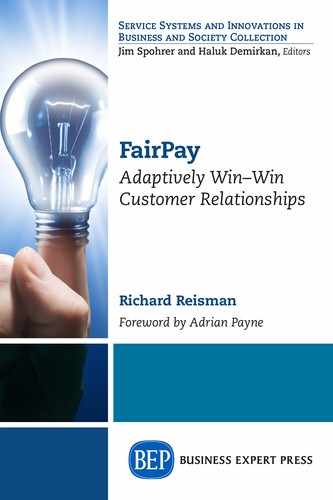If the idea of pricing for realized value makes sense at all, why not down through the supply chain? Some limited suggestions of how that might work have been discussed earlier. However, this gets into complex B2B relationships, and it is difficult to address this in very specific terms before there is more clarity on how businesses and consumers apply FairPay. So this chapter is a place-holder, merely intended to point in some general directions.
This discussion also applies to multisided markets, in which hub services enable an Actor-to-Actor market topology that can work as a supply chain. For example, a Web service may act as a marketplace linking consumers, advertisers, content providers, service providers, app developers, and the like (much as Facebook is currently seeking to do).
Some industries, such as journalism, have vertical integration and generally make use of in-house creative talent, so managing incentives and rewards in such supply chains is internal to the business, and thus relatively easy to manage. News providers can work out their own compensation structures with their journalists to exploit customer value feedback as a compensation factor, as discussed in Chapter 8. But, as noted there, even news often has independent supply sourcing and layers of curation and distribution—as is a current trend, as Facebook, Blendle, and others provide multisided markets for news.
Music makes for an interesting case study, since that industry already has all of the issues that make FairPay promising—and (as both good news and bad news) music has a well-developed supply chain with clear need for more fairness in pricing at all levels of the chain. Chapter 9 noted how this has become a high profile sore point, such as when the artist Taylor Swift pulled her music from Spotify, and then later got Apple to change the payment policy for their new music subscription service. Thus there is strong motivation to develop pricing that properly links the value proposition all the way up and down the chain, so that artists and fans, and those in between, are optimally aligned. These issues are briefly explored in that chapter.
Other industries have a range of supply chain models, some much like music, some with mixtures of in-house and independent creative supply, and some mostly in-house.
A core idea is that transparency can enhance the dialogs on value—and customer feedback on value should inform the sharing of the value surplus all along the chain. As we build out this Cloud of Value, customers should both have some transparency into how their payments are shared with creators and various layers of middlemen—and should have some say in those allocations. Similarly, the intermediate levels should participate in evaluation of what value they receive, and what they provide. This obviously needs to be done without undue complexity or friction, and with defaults that are workable when explicit guidance is lacking or impractical. It seems that there are many ways such structures could be developed, and just what shape they take is likely to depend on the nature of the business, the market, and the level of maturity in using FairPay. Early versions should keep it as simple as possible—but in time, some participation in pricing seems desirable and workable along all important levels of the chain.
